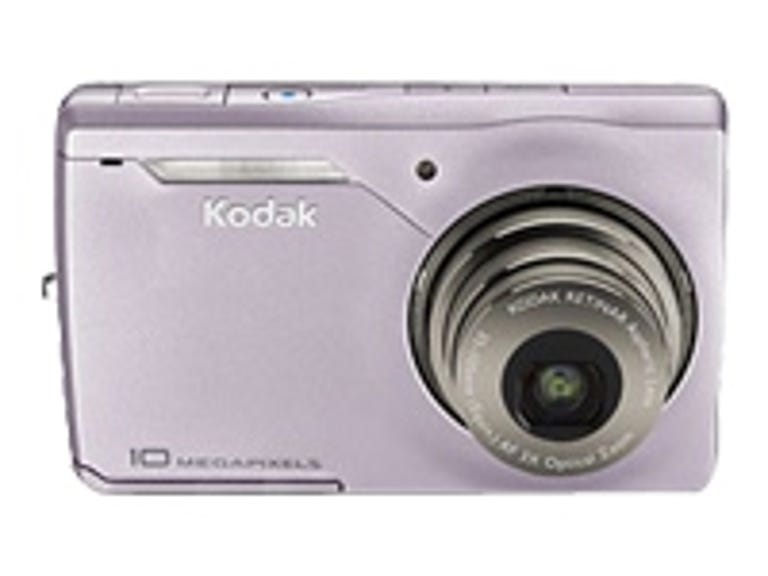 Why You Can Trust CNET
Why You Can Trust CNET Kodak EasyShare M1033 review: Kodak EasyShare M1033
Kodak EasyShare M1033
At first glance the 10-megapixel Kodak EasyShare M1033 is a fairly basic budget pocket camera. It's basic at second, third, and well, every subsequent glance, too. But that's the M1033's greatest asset: it's a simple-to-operate, stylish ultracompact camera that takes good--occasionally excellent--pictures without much thought from the user. It won't blow you away with features and performance, but it doesn't disappoint either.
The Good
The Bad
The Bottom Line
Measuring 2.3 inches tall by 3.7 inches wide by 0.8 inch deep, the M1033 slides easily into a back pocket, and at 5.2 ounces, it won't weigh you down, either. The camera's mostly metal body comes in six colors--black, silver, pink, copper, red, and gray--feels sturdy, and has a clear-cut design, so you can hand the camera to anyone and let them shoot away.
Buttons for the shutter, power, flash, and mode selections are on top, flush with the body, adding to the camera's streamlined looks. On back is a 3-inch LCD that's bright enough to remain visible in sunlight. A relatively large rocker zoom switch for the 3x 35-105mm-equivalent f3.1-5.7 lens is well positioned to the top left of the screen. Below it sits a five-way joystick for navigating menus and for the playing of images and video. That's flanked by Delete, Playback, Menu, and Kodak's standard Share button, which lets you tag an image to be printed or e-mailed the next time the camera is connected to a computer.
Powering on to first shot takes 1.7 seconds on average and typically takes the same amount of time from shot to shot. Using the flash adds nearly a second to that. Shutter lag is very good for its class at only 0.4 second in bright conditions and 0.9 in dim. Burst mode offers only a three-shot spurt in approximately 1.4 seconds. It's important to note that if you let it--by pressing the shutter button completely rather than halfway and waiting for a focus confirmation--the M1033 will take a picture without locking focus. This does let you capture images extremely quickly, but they'll frequently be blurry.
Press the Mode button and you get four options: Smart Capture, Program, Scene, and Video. Smart Capture mode integrates scene and face detection, optimized auto ISO, and a broader dynamic range among other things, so you truly don't have to worry about a setting to take a decent picture. This mode also applies Kodak's PerfectTouch technology to help improve detail and contrast. In general this system works, producing fine photos regardless of subject or lighting conditions. Which is good, since the camera always starts in Smart Capture, regardless of your settings at power off.
The M1033 also has 22 Scene modes you can switch to in seconds. These include standards like portrait and landscape as well as things like in-camera panorama (left to right and right to left), candle light, panning, and blur reduction. The Program mode gives you slightly more control for exposure compensation and metering, color (natural, low, black and white, sepia), white balance, and ISO. It's nice to have, though I'm not sure it's wholly necessary.

Again, the M1033 is capable of shooting some very nice photos for its class, though more often they're a mixed bag. Like most budget models, the Kodak performs best in bright sunlight. Overall, colors are pleasing, though white balance is quite inconsistent. For example, when shooting a mix of plants, the colors would shift depending on which plant was the subject. There's also some serious vignetting--darkening around the edges--and modest distortion at the camera's widest angle.
Lastly, one of the hyped features on the M1033 is its 720p (1,280x720) video recording at up to 30fps. However, the HD-recording performance was a little disappointing. The picture is good, but my results display some stuttering when panning, and while you can zoom while recording, focusing is slow and you could hear it working in the recorded audio. Exposure control seems to be a bit of an issue, too. The image stabilization can't be turned on when recording at 1,280x720, either (you'll have to drop to 640x480, since electronic image stabilization requires the extra pixels to do its work). The moral: if you are considering buying this to shoot handheld HD clips longer than 30 seconds, don't.
The Kodak EasyShare M1033 might not be overflowing with features or staking major performance claims, but it is a respectable budget ultracompact with good looks and simple operation. And there's nothing wrong with that.
(Smaller bars indicate better performance)
| Time to first shot | Typical shot-to-shot time (flash) | Typical shot-to-shot time | Shutter lag (dim) | Shutter lag (typical) |
(Longer bars indicate better performance)


